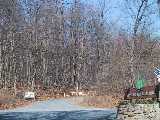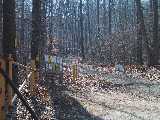A fourth major entrance of note, if hardly the best for relatively easy climbing to the tower, is that of Horseshoe Trail which runs through the park (a branch from and sibling of the much more well-known Appalachian Trail, only unlike the AT, horses are welcome in the park and on the Horseshoe Trail; a good thing, considering its name . . .). The eastern entrance is from Old Rte. 72, which can best be found on the western side of the present Rte. 72, about a half-mile south of the interchange with Rte. 117, and about 2 miles north of the PA Turnpike interchange. It is directly opposite the well-marked entrance to Spring Hill Acres housing development. March up Old Rte. 72 beyond the barrier and the trail entrance is on the left.
At the old Rte. 72 entrance there is off-road parking space for a few vehicles in the space in front of the barrier. Again, don't block the entrance.
|
 |


